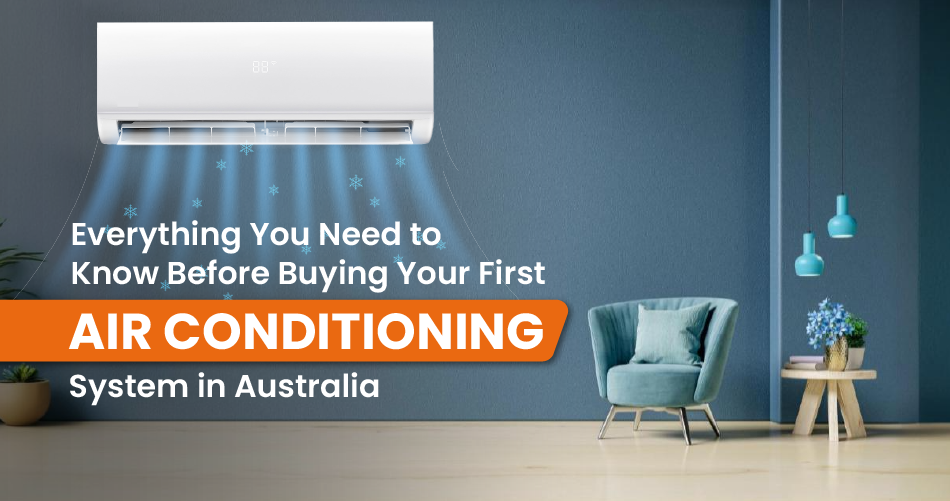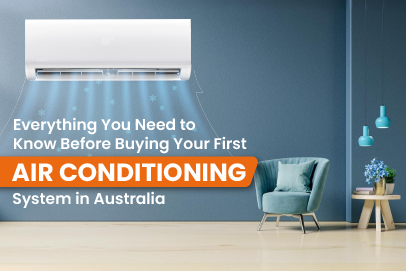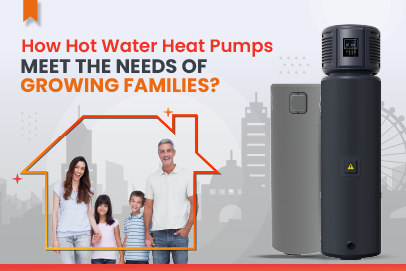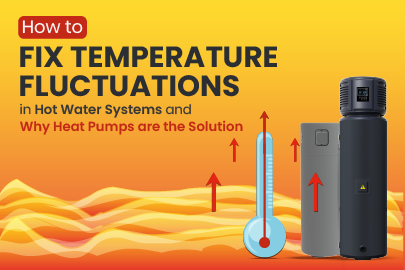Choosing the right air conditioning system is essential for comfort, energy efficiency, and long-term savings, especially in a country with such diverse climates as Australia. Whether you're a first-time buyer or looking to upgrade, this aircon guide will equip you with all the necessary insights to make an informed decision.
Why Investing in the Right Air Conditioning Matters
A good aircon system isn't just about cooling your home; it’s an investment in energy efficiency, cost savings, and indoor comfort. Modern air conditioning are designed to cater to various climates and offer smart features that improve convenience and energy management.
Common Mistakes to Avoid:
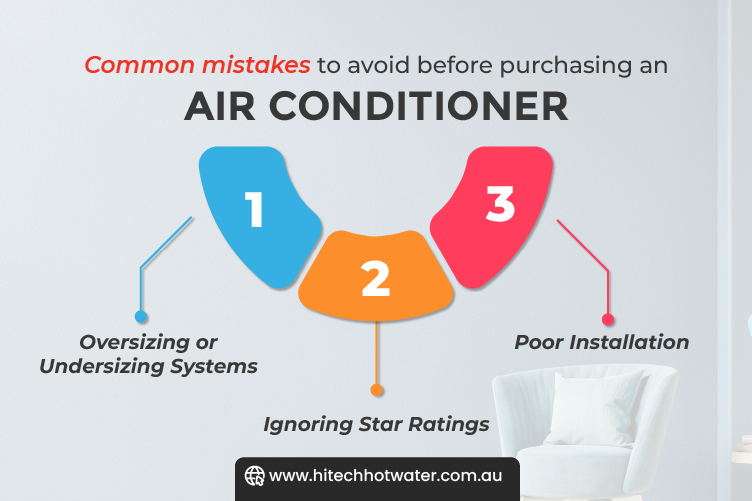
- Oversizing or Undersizing Systems: Installing a system too large or too small for your space can lead to inefficiency and higher energy costs.
- Ignoring Star Ratings: Overlooking energy efficiency ratings can result in higher electricity bills.
- Poor Installation: Hiring unlicensed installers can void warranties and compromise system performance.
Types of Air Conditioning Explained
1. Split System Air Conditioners
Ideal for single rooms or small spaces, split systems are Australia’s most popular aircon choice.
- Pros: Energy-efficient, quiet operation, and customizable for different rooms.
- Cons: Limited to specific areas; requires professional installation.
2. Ducted Air Conditioning
These systems provide centralized cooling for the entire home via concealed ducts.
- Pros: Aesthetic appeal and uniform cooling throughout the house.
- Cons: High upfront cost and complex installation process.
3. Portable and Window Units
Best suited for renters or those seeking a temporary solution.
- Pros: Affordable, easy to set up, and portable.
- Cons: Noisy operation, limited cooling power, and higher energy consumption.
4. Reverse Cycle Air Conditioners
These versatile systems offer both heating and cooling, making them perfect for year-round use.
- Pros: Dual functionality, energy-efficient, and suitable for Australian climates.
- Cons: Slightly higher upfront cost compared to basic systems.
5. Evaporative Coolers
Best for dry climates, these systems use water evaporation to cool the air.
- Pros: Energy-efficient and eco-friendly.
- Cons: Less effective in humid areas and requires access to water.
Factors to Consider Before Buying an Air Conditioning System
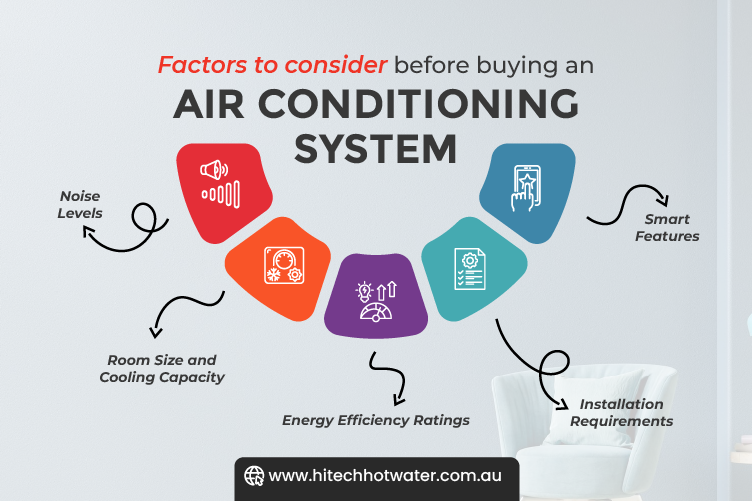
Room Size and Cooling Capacity:
Measure the area you want to cool and match it with the system's BTU rating. Example: A 20m² room requires about 2.5 kW of cooling capacity.
Energy Efficiency Ratings:
Higher star ratings indicate better efficiency. According to Energy.gov.au, upgrading to a high-efficiency aircon can save households up to $200 annually on energy bills.
Noise Levels:
For bedrooms, choose systems with low decibel ratings (<30 dB). Portable units tend to be noisier, making them less ideal for quiet spaces.
Smart Features:
Modern aircon systems with Wi-Fi connectivity allow remote control and energy usage monitoring, enhancing convenience and efficiency.
Installation Requirements:
Ensure you hire licensed professionals to comply with Australian standards and avoid warranty voids.
Choosing the Right Air Conditioning for Australian Homes
Regional Considerations
- Coastal Areas: Opt for anti-corrosion units to withstand salt exposure.
- Dry Climates: Choose systems with powerful cooling capabilities.
- Humid Climates: Look for units with built-in dehumidification.
Seasonal Considerations
Summer installations are more convenient due to better weather conditions, while winter installations may have reduced demand, resulting in cost savings.
Comparing Operating Costs Across Aircon Types
The operating costs of air conditioning vary significantly based on the type of system, room size, and usage. The figures below are sourced from reputable organizations, including Canstar Blue, Sustainability Victoria, and Choice Australia, which provide reliable data on energy consumption and costs for Australian households.
|
Aircon Type |
Usage Context |
Annual Operating Costs |
|
Split Systems |
Small Rooms (up to 20m²) |
$30–$155 |
|
|
Medium Rooms (20–40m²) |
$48–$258 |
|
|
Large Rooms (40–60m²) |
$73–$396 |
|
Ducted Systems |
Small Rooms (up to 20m²) |
|
|
|
Medium Rooms (20–40m²) |
$101–$258 |
|
|
Large Rooms (40–60m²) |
$125–$188 |
|
Portable Units |
General Use (4 hours/day for 3 months) |
$173 (seasonal cost) |
The figures in the table highlight how different aircon types can impact long-term costs, with ducted systems being more suitable for larger homes but carrying higher annual expenses, while split systems are ideal for smaller or medium-sized spaces with moderate costs.
Smart Technology: The Future of Air Conditioning
Modern aircon solutions are integrating smart technology, making it easier to manage energy use while maintaining comfort. Features like Wi-Fi-enabled controls and compatibility with smart home systems allow users to:
- Monitor Energy Usage: Real-time data helps optimize system performance and reduce energy bills.
- Schedule Cooling: Pre-program the system to activate during peak heat times or deactivate when no one is home.
- Voice Control Integration: Many systems are now compatible with Alexa, Google Assistant, or other voice-activated devices, offering convenience and accessibility.
These advancements not only enhance user experience but also contribute to greater energy efficiency.
Environmental Benefits of Energy-Efficient Aircon Solutions
Investing in an energy-efficient air conditioning isn’t just good for your wallet—it’s a step toward environmental sustainability. High-efficiency systems use up to 30% less energy than older models, significantly reducing greenhouse gas emissions. Additionally:
- Reduced Refrigerant Impact: Newer systems use eco-friendly refrigerants like R32, which have a lower global warming potential.
- Support for Renewable Energy: Pairing your aircon system with solar PV enhances sustainability while offsetting operational costs.
Maintenance and Energy Efficiency Tips
Maintaining your aircon solutions ensures longevity and optimal performance, this aircon guide shows exactly how to do it:
- Regular Filter Cleaning: Dirty filters reduce efficiency by up to 15%. Clean them monthly or as recommended.
- Seal Doors and Windows: Prevent cool air from escaping by sealing gaps.
- Set Smart Thermostat Controls: Keep the temperature at 24°C–26°C for energy-efficient cooling.
- Professional Servicing: Schedule annual check-ups to address issues like refrigerant levels and compressor health.
Energy-saving habits can also lower your bills. For instance, using ceiling fans alongside air conditioning can reduce cooling costs by 10%–20%.
Rebates and Incentives for Air Conditioning in Australia
New South Wales
- Energy Savings Scheme (ESS): Offers rebates for energy-efficient air conditioning installations.
- Peak Energy Reduction Scheme (PERS): Encourages households to reduce peak electricity demand.
Victoria
- Victorian Energy Efficiency Certificates (VEEC): Subsidizes energy-efficient systems, reducing upfront costs.
Federal Programs
- Small-Scale Renewable Energy Scheme (SRES): Provides incentives for installing energy-efficient appliances, including air conditioning.
These programs make energy-efficient aircon solutions more affordable while supporting Australia’s sustainability goals.
Additional Considerations
Warranty and After-Sales Support:
Look for brands that offer extensive warranties (5–10 years) and responsive customer support.
Resale Value:
Installing a high-quality air conditioning can increase your home's value, particularly in Australia’s competitive real estate market.
Eco-Friendly Systems:
Consider systems with R32 refrigerant, which has a lower global warming potential compared to older refrigerants.

Conclusion
Investing in the right air conditioning system ensures year-round comfort, energy efficiency, and cost savings for Australian households. By understanding what mentioned in this aircon guide the types of aircon, considering local conditions, and leveraging government rebates, you can make a smart, sustainable choice for your home.
For expert advice and professional installation services, visit HiTech Hot Water

